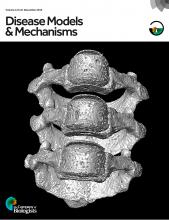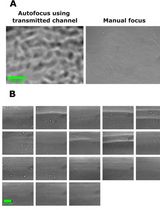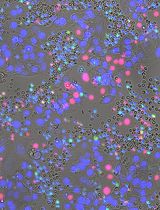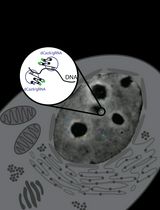- 提交稿件
- 订阅
- CN
- EN - English
- CN - 中文
- EN - English
- CN - 中文
Live Intravital Intestine with Blood Flow Visualization in Neonatal Mice Using Two-photon Laser Scanning Microscopy
用双光子激光扫描显微镜观察新生小鼠活体肠内血流
发布: 2021年03月05日第11卷第5期 DOI: 10.21769/BioProtoc.3937 浏览次数: 6033
评审: Yuangang ZhuLiang-Chun WANGSalah Boudjadi
Abstract
This protocol describes a novel technique to investigate the microcirculation dynamics underlying the pathology in the small intestine of neonatal mice using two-photon laser-scanning microscopy (TPLSM). Recent technological advances in multi-photon microscopy allow intravital analysis of different organs such as the liver, brain and intestine. Despite these advances, live visualization and analysis of the small intestine in neonatal rodents remain technically challenging. We herein provide a detailed description of a novel method to capture high resolution and stable images of the small intestine in neonatal mice as early as postnatal day 0. This imaging technique allows a comprehensive understanding of the development and blood flow dynamics in small intestine microcirculation.
Keywords: Intravital imaging (活体成像)Background
Development of in vivo real-time imaging
Recent technological advances are overcoming the limitations of conventional histological analysis by enabling live imaging on experimental animals. In contrast to conventional histological microscopy techniques, the intravital approach provides insight into previously unknown morphogenetic and functional processes in live tissues. Furthermore, this information can be acquired in real time lapses, whereas alternative techniques are limited to a snapshot in time. The alternative techniques have the added requirement of determining the best timing to acquire images during a specific process in an experimental protocol.
Two-photon laser-scanning microscopy (TPLSM), compared to confocal microscopy, offers in vivo imaging that is superior for deep optical sectioning of living tissue (Pittet and Weissleder, 2011). The higher resolution and reduced phototoxicity of this method allow longer time periods of continuous real-time imaging on intact organs. We have standardized in vivo real-time imaging of intra-abdominal organs through TPLSM and used it to study the contribution of abnormal intestinal microcirculation in pathophysiological processes. For example, we have used this technology to study bacterial translocation in dextran sodium sulfate (DSS)-induced colitis (Toiyama et al., 2010), neutrophil extracellular traps (Tanaka et al., 2014a), thrombus formation in laser-induced endothelium injury (Koike et al., 2011), visualization of chemotherapy responses of colorectal liver metastases to the tumor microenvironment (Tanaka et al., 2014b), and the dynamics of circulating free DNA in a model of DSS-induced colitis (Koike et al., 2014). Additionally, previous reports have shown the application of intravital multiphoton microscopy to study pathophysiological processes in other abdominal organs including the liver (Honda et al., 2013; Lu et al., 2014; Liang et al., 2015), pancreas (Coppieters et al., 2010; Martinic and von Herrath, 2008), spleen (Ferrer et al., 2012), and kidneys (Peti-Peterdi et al., 2012; Hackl et al., 2013; Devi et al., 2013; Schiessl and Castrop, 2013).
In recent years TPLSM has become increasingly popular in in vivo research. However, intravital imaging of the small intestine in neonatal mice has been challenging due to their small body size and fragility of the intestinal wall. We have developed a novel application of TPLSM to visualize and study the small intestine of neonatal mice in vivo.
Advantages of the method
Two of the key advances of TPLSM are deeper tissue penetration and reduced photobleaching. These advances have facilitated the study of dynamic processes in vivo while minimizing injury to the organ or cell under investigation. Obtaining intravital stable images of the gastrointestinal tract has been difficult due to the movements caused by heartbeat, respiration, and intestinal peristalsis. To reduce the effects of these movements, we and others have purposefully designed devices and equipment that improve live image stability of the gastrointestinal tract (Watson et al., 2005; McDole et al., 2012; Ritsma et al., 2013). However, setting up such devices is time consuming, costly, and present technical challenges that require extensive trial and error. Current systems of choice for stabilizing intravital imaging are: a viewing window with a vacuum chamber (Looney et al., 2011), a microstage device (Cao et al., 2012), and our previously designed organ stabilizer (Japanese Patent No. 5268282) (Toiyama et al., 2010). These methods have been used for imaging the small intestine in adult mice, however, none of them have been applied to the imaging of the neonatal small intestine. One reason for this is that these devices are too large and limit the working space for the neonatal small intestine. To limit the movements induced by heartbeat and breathing during imaging, it is important that the organ stabilizer is detached from the neonatal abdominal wall. In addition, fixation maneuvers required when using previously developed organ stabilizing devices can cause injury or affect the neonatal intestinal microcirculation.
Our method allows for direct microvascular blood flow analysis. Stappenbeck TS et al. (2002) reported a method to analyze intestinal microcirculation indirectly from intestinal tissue samples harvested immediately after injecting fluorescein isothiocyanate-labeled dextran into the heart (Yu et al., 2009; Watkins and Besner, 2013; Yazji et al., 2013). However, thisand other similar methods for intravital imaging of the adult mouse intestine are not functional in blood flow dynamics. Our method allows for blood flow dynamics analysis, and facilitates investigation of intestinal villi development and establishment of the capillary network complexity (Stappenbeck et al., 2002). This protocol will allow the investigation of pathological processes associated with intestinal blood flow dynamics in vivo, thus promoting translational research.
The method we describe in this protocol is simple, overcomes the limitations of previous systems, and allows for stable live imaging of the neonatal mouse small intestine. This method interferes minimally with the microcirculation and enables high resolution intravital imaging of the small intestine for long periods of time. This protocol allows for unprecedented stability of intravital imaging of the neonatal small intestine.
Applications of the method
The TPLSM imaging method described here can be easily applied to investigate different physiological processes in the neonatal intestine in multiple mouse models. For example, we are using this method to study blood flow dynamics and inflammatory responses in necrotizing enterocolitis (NEC), intestinal epithelium and micro-vasculature development in short bowel syndrome (SBS), inflammatory and immunological status in inflammatory bowel disease (IBD), and ischemia-reperfusion injury in midgut volvulus. Previous studies investigated neonatal intestinal microcirculation in experimental NEC ex vivo, however, these studies did not consider the effects of blood flow dynamics in capillary-vessels in the villi. Our new method allowed us to measure neonatal intestinal microcirculation from movies of live blood flow and to derive blood flow velocity, vessel diameter and inflammation, and assess irrigation of the serosal and mucosal layers. Moreover, this technique is being used to visualize and quantify live blood flow dynamics during reperfusion and ischemia in experimental midgut volvulus, which will be useful to identify the primary intestinal tissues affected.
Here, we provide a step-by-step methodology to set up the neonatal mouse small intestine using a simple stabilizing device to evaluate the intestinal microcirculation by TPLSM.
Limitation of the approach
The proximal jejunum close to the ligament of Treitz is difficult to study due to its proximity and attachment to the abdominal wall. The described technique allows for analysis of the small intestine between the anterior superior iliac spine and the xiphoid process transversely, and between the sternum and the posterior abdominal wall longitudinally. Analyzing the intestine outside these marking points (for instance, in portions of the colon) may lead to potential bleeding from the mesentery due to excessive stretching applied on the intestine for appropriate positioning. Additionally, the device is limited to areas of the intestine that are naturally close to the abdominal wall without the need for heavy manipulation to avoid potential intestinal damage. The organ stabilizing device should not be in direct contact with the mouse abdominal wall to avoid image instability caused by movements due to breathing and heartbeat.
Considerations for intestinal preparation
The neonatal mouse should be fasted for at least 4 hours before microscopic observation since food residue within the intestinal lumen could affect the imaging results by affecting intestinal blood flow and/or potential for development of ischemia. Some reports have shown that intestinal blood flow varies by gestational age and feeding time (Pezzati et al., 2004; Watkins and Besner, 2013; Thompson et al., 2014; Morgan et al., 2014), suggesting that feeding tolerance should also be considered in the study protocol. Therefore, for analyzing the small intestine microcirculation using this method, a fixed fasting duration and gestational age between for all mice being used should be considered before starting the experiment to allow for appropriate comparison. The ideal fasting time to use will vary depending on the specific parameters to be measured in the neonatal small intestine. For example, 6-hour fasting allows proper imaging of the neonatal ileum in 5-day old pups subjected to experimental NEC, but this may vary if examining a different disease or mice of a different age. The varying effects on blood circulation secondary to feeding should be minimized by maintaining a homogenous feeding schedule and fasting duration across all mice being examined.
Procedure for NEC induction
NEC is induced by gavage feeding a hyperosmolar formula gavage, exposure to temporal hypoxia and oral administration of lipopolysaccharide (LPS) (Zani et al., 2008). Gavage feeding is given 3 times a day, using a 1.9-Fr silicon catheter (Vygon UK Ltd, Gloucestershire, UK). The hyperosmolar formula is prepared with 15 g of SMA Gold (SMA Nutrition, Berkshire, UK) in 75 ml of Esbilac canine supplement (Pet-Ag Inc., Hampshire, IL) (Barlow et al., 1974). Pups are exposed to hypoxia before each feed by placing them in a hypoxic chamber containing a gas mixture of 5% O2 and 95% N2 for 10 min, monitored with an O2 gas detector (BW O2 Gas Alert Clip Extreme, Rockall Confined & Safety, Cardiff, UK). LPS is administered on the 1st and 2nd day after NEC induction; mice are gavaged with 4 mg/kg/day LPS (lipopolysaccharide from Escherichia coli 0111:B4, Sigma-Aldrich Company Ltd., Dorset, UK) mixed within the formula feed. During the whole experiment, mice are kept in a neonatal incubator to maintain temperature (30 °C) and humidity (40%).
Materials and Reagents
Note: All reagents may be substituted with appropriate alternatives from other manufacturers.
Consumables
Sterile 1.0 ml syringe with 26 Gauge needle or smaller (VWR, catalog number: 309597 )
Sterile gauze (VWR, catalog number: CA95041-740 )
Soft absorbable pad (VWR, catalog number: 95057-862 )
Rubber grove
Kimwipes (VWR, catalog number: 102097-615 )
Microscope slides (VWR, catalog number: 48311-703 , 1.0 mm thickness)
Microscope cover glass (VWR, catalog number: 48393-172 , 0.13-0.17 mm thickness)
Falcon tube (15 ml) (VWR, catalog number: CA60819-761 )
Adhesive tape (VWR, catalog number: 89097-912 )
Animals
Neonatal ROSAmT/mG;Tie2-Cre mice of both sexes were used to visualize the hemodynamics of small intestinal microcirculation and leukocyte movement. Table 1 shows a comprehensive list of transgenic mouse lines carrying fluorescent reporters that could be used in this protocol. Alternative transgenic reporter lines expressing fluorescent proteins can also be used in this method.
!Caution: Please note that all animal experiments should be performed following ethical guidelines and regulations of both the animal and imaging facilities. Research should not begin until use live animals is approved by the facility’s Animal Care Committee.
Table 1. Fluorescent positive mouse lines
| Name | Strain | Type | Promoter | Specificity |
| GFP mouse | C57BL/6 | Tg(CAG-EGFP) | Chicken β-Actin and cytomegalovirus enhancer | All tissues except for erythrocytes and hair appear green under excitation light. |
| mTmG mouse | C57BL/6 | RosamTmG | Chicken β-Actin/pCA | These mice possess loxP sites on either side of a membrane-targeted tdTomato (mT) cassette and express strong red fluorescence in all tissues and cell types examined. When bred to Cre recombinase expressing mice, the resulting offspring have the mT cassette deleted in the Cre expressing tissue(s), allowing expression of the membrane-targeted EGFP (mG) cassette located just downstream. |
| Tie2 Cre | (C57BL/6 x SJL)F1 | Tek-cre | Tek, endothelial-specific receptor tyrosine kinase | These transgenic mice express Cre recombinase under the control of a mouse Tek promoter and enhancer. This promoter is active in endothelial cells. |
Reagents
Sterile Phosphate-buffered saline (PBS, 1×, pH 7.2)
Ultra-purified water
Disinfectant: 70% ethanol solution (70 ml of 100% ethanol added to 30 ml of water)
Equipment
Note: All equipment may be substituted with appropriate alternatives from other manufacturers.
General Equipment
Appropriate microscope stage (Zeiss LSM710 motorized X, Y stage with Z focus) with heating pad (FHC Inc., catalog number: 40-90-2-07 , Bowdoin, ME, USA)
Gas anesthesia vaporizer ( IsoTec4 ; Datex-Ohmeda GE Healthcare, Waukesha, WI, USA)
Oxygen gas
Hair removal cream (Nair® hair remover cream for face)
Curved blunt forceps (VWR, catalog number 76319-850)
Fine forceps (VWR, catalog number 82027-408)
Scissors
!Caution: Only use the tip of sharp scissors when conducting fine neonatal mouse surgery. This will allow for more precise work with less tissue damage.
Solder lug terminal; 0.3 mm; M4 (Manufacturer OSTERRATH, manufacturer part number 60-2814-51/0030 , Figure2A)
Holding devices for both the cover glass and solder lug terminal (TEKTON 7521 Helping Hand with Magnifier, Figure 2C)
Microscope
Inverted two-photon laser scanning microscope (TPLSM, e.g., Zeiss LSM710 )
Laser: Ti:Sapphire Chameleon Vision (Coherent)
Objectives: 20× (Water immersion lens, e.g., Zeiss W Plan APOCHROMAT, 1.0 DIC (UV) VIS-IR∞/0.17)
Software application: ZEN (Zeiss, imaging software)
Note: Magnifiers are not needed in this study and can be removed from the device.
Anesthesia
Portable anesthesia machine
Isoflurane vaporizer
Anesthesia breathing circuit
O2 gas flow regulator for E-cylinders (Praxair)
O2 tank (E-cylinder)
Anesthesia breathing circuit and nose cone
Procedure
文章信息
版权信息
© 2021 The Authors; exclusive licensee Bio-protocol LLC.
如何引用
Koike, Y., Li, B., Chen, Y., Ganji, N., Alganabi, M., Miyake, H., Lee, C., Hock, A., Wu, R., Uchida, K., Inoue, M., Delgado Olguin, P. and Pierro, A. (2021). Live Intravital Intestine with Blood Flow Visualization in Neonatal Mice Using Two-photon Laser Scanning Microscopy. Bio-protocol 11(5): e3937. DOI: 10.21769/BioProtoc.3937.
分类
细胞生物学 > 细胞成像 > 活细胞成像
发育生物学 > 形态建成
您对这篇实验方法有问题吗?
在此处发布您的问题,我们将邀请本文作者来回答。同时,我们会将您的问题发布到Bio-protocol Exchange,以便寻求社区成员的帮助。
提问指南
+ 问题描述
写下详细的问题描述,包括所有有助于他人回答您问题的信息(例如实验过程、条件和相关图像等)。
Share
Bluesky
X
Copy link












